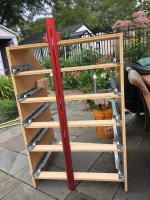Hello,
I am in the process of getting a small shop up and running, and was looking to get a bit of advice from those here at FOG. I have found discussions involving Festool in other forums can quickly become toxic and less informative. I hope you all can provide some insight. My apologies if this is the wrong forum for this post.
I am interested in the TS55 and its ability to do the job of few different saws. I would like to get something that would be able to replace a table saw and miter saw, but wanted to see if the TS55 was the best option available or if something like the Makita track saw could do what the TS55 does, at a much cheaper price point. I understand that at some point a table saw may be needed, but it seems like I could avoid one for quite some time with the TS55?
I will be redoing our kitchen in the spring (cabinets/countertops), have plans on building a small deck in the backyard, and short of fly fishing and skiing, found woodworking to be one of the most enjoyable hobbies I have experienced. I am still relatively young, with young children and our first home, so I would like a tool that has the versatility to perform a wide variety of tasks, but do not want to spend this kind of money if there is something that would work just as well for a cheaper cost. I am just a hobbyist and by no means a professional, and I do realize that much of Festool's product line is aimed at professional carpenters. Am I crazy for even considering this saw? I know for cabinet making and decks, it seems perfect. I guess I am wondering how practical the saw would be for more general woodworking? I understand the price point is certainly not considered cheap, but if I could avoid having to purchase a table saw and miter saw that softens the blow of the cost. Everything I have read and watched concerning the saw seems to indicate a very fine edge when cutting and the versatility to perform a wide variety of cuts. How would the HK55 compare to the TS55 in overall performance and versatility? I read one post on here from someone explaining their decisions to go with the HK55 - which was insightful and helpful - but there was not much said about the TS55.
If any of you all could take a moment to let me know if you think the TS55 is a nice option, or if the HK55 would be able to do the same jobs/task just as well. Also, is there another saw that you would suggest more so than the TS55 or HK55, like the Makita track saw?
Thank you for your time.
Brent
I am in the process of getting a small shop up and running, and was looking to get a bit of advice from those here at FOG. I have found discussions involving Festool in other forums can quickly become toxic and less informative. I hope you all can provide some insight. My apologies if this is the wrong forum for this post.
I am interested in the TS55 and its ability to do the job of few different saws. I would like to get something that would be able to replace a table saw and miter saw, but wanted to see if the TS55 was the best option available or if something like the Makita track saw could do what the TS55 does, at a much cheaper price point. I understand that at some point a table saw may be needed, but it seems like I could avoid one for quite some time with the TS55?
I will be redoing our kitchen in the spring (cabinets/countertops), have plans on building a small deck in the backyard, and short of fly fishing and skiing, found woodworking to be one of the most enjoyable hobbies I have experienced. I am still relatively young, with young children and our first home, so I would like a tool that has the versatility to perform a wide variety of tasks, but do not want to spend this kind of money if there is something that would work just as well for a cheaper cost. I am just a hobbyist and by no means a professional, and I do realize that much of Festool's product line is aimed at professional carpenters. Am I crazy for even considering this saw? I know for cabinet making and decks, it seems perfect. I guess I am wondering how practical the saw would be for more general woodworking? I understand the price point is certainly not considered cheap, but if I could avoid having to purchase a table saw and miter saw that softens the blow of the cost. Everything I have read and watched concerning the saw seems to indicate a very fine edge when cutting and the versatility to perform a wide variety of cuts. How would the HK55 compare to the TS55 in overall performance and versatility? I read one post on here from someone explaining their decisions to go with the HK55 - which was insightful and helpful - but there was not much said about the TS55.
If any of you all could take a moment to let me know if you think the TS55 is a nice option, or if the HK55 would be able to do the same jobs/task just as well. Also, is there another saw that you would suggest more so than the TS55 or HK55, like the Makita track saw?
Thank you for your time.
Brent

